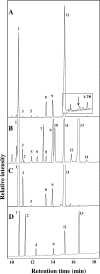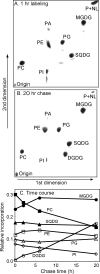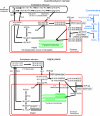Genomic and biochemical analysis of lipid biosynthesis in the unicellular rhodophyte Cyanidioschyzon merolae: lack of a plastidic desaturation pathway results in the coupled pathway of galactolipid synthesis
- PMID: 17416897
- PMCID: PMC1951526
- DOI: 10.1128/EC.00393-06
Genomic and biochemical analysis of lipid biosynthesis in the unicellular rhodophyte Cyanidioschyzon merolae: lack of a plastidic desaturation pathway results in the coupled pathway of galactolipid synthesis
Abstract
The acyl lipids making up the plastid membranes in plants and algae are highly enriched in polyunsaturated fatty acids and are synthesized by two distinct pathways, known as the prokaryotic and eukaryotic pathways, which are located within the plastids and the endoplasmic reticulum, respectively. Here we report the results of biochemical as well as genomic analyses of lipids and fatty acids in the unicellular rhodophyte Cyanidioschyzon merolae. All of the glycerolipids usually found in photosynthetic algae were found, such as mono- and digalactosyl diacylglycerol, sulfolipid, phosphatidylglycerol, phosphatidylcholine, phosphatidylethanolamine, and phosphatidylinositol. However, the fatty acid composition was extremely simple. Only palmitic, stearic, oleic, and linoleic acids were found as major acids. In addition, 3-trans-hexadecanoic acid was found as a very minor component in phosphatidylglycerol. Unlike the case for most other photosynthetic eukaryotes, polyenoic fatty acids having three or more double bonds were not detected. These results suggest that polyunsaturated fatty acids are not necessary for photosynthesis in eukaryotes. Genomic analysis suggested that C. merolae lacks acyl lipid desaturases of cyanobacterial origin as well as stearoyl acyl carrier protein desaturase, both of which are major desaturases in plants and green algae. The results of labeling experiments with radioactive acetate showed that the desaturation leading to linoleic acid synthesis occurs on phosphatidylcholine located outside the plastids. Monogalactosyl diacylglycerol is therefore synthesized by the coupled pathway, using plastid-derived palmitic acid and endoplasmic reticulum-derived linoleic acid. These results highlight essential differences in lipid biosynthetic pathways between the red algae and the green lineage, which includes plants and green algae.
Figures








Similar articles
-
Uncommon properties of lipid biosynthesis of isolated plastids in the unicellular red alga Cyanidioschyzon merolae.FEBS Open Bio. 2018 Dec 4;9(1):114-128. doi: 10.1002/2211-5463.12551. eCollection 2019 Jan. FEBS Open Bio. 2018. PMID: 30652079 Free PMC article.
-
Identification of genes for sulfolipid synthesis in primitive red alga Cyanidioschyzon merolae.Biochem Biophys Res Commun. 2016 Jan 29;470(1):123-129. doi: 10.1016/j.bbrc.2016.01.006. Epub 2016 Jan 6. Biochem Biophys Res Commun. 2016. PMID: 26768360
-
ACYL-LIPID DESATURASE2 is required for chilling and freezing tolerance in Arabidopsis.Plant Cell. 2013 Apr;25(4):1430-44. doi: 10.1105/tpc.113.111179. Epub 2013 Apr 12. Plant Cell. 2013. PMID: 23585650 Free PMC article.
-
DGDG and Glycolipids in Plants and Algae.Subcell Biochem. 2016;86:51-83. doi: 10.1007/978-3-319-25979-6_3. Subcell Biochem. 2016. PMID: 27023231 Review.
-
Green light for galactolipid trafficking.Curr Opin Plant Biol. 2004 Jun;7(3):262-9. doi: 10.1016/j.pbi.2004.03.009. Curr Opin Plant Biol. 2004. PMID: 15134746 Review.
Cited by
-
Complex origins of chloroplast membranes with photosynthetic machineries: multiple transfers of genes from divergent organisms at different times or a single endosymbiotic event?J Plant Res. 2020 Jan;133(1):15-33. doi: 10.1007/s10265-019-01157-z. Epub 2019 Dec 6. J Plant Res. 2020. PMID: 31811433 Free PMC article.
-
Accelerated triacylglycerol production without growth inhibition by overexpression of a glycerol-3-phosphate acyltransferase in the unicellular red alga Cyanidioschyzon merolae.Sci Rep. 2018 Aug 17;8(1):12410. doi: 10.1038/s41598-018-30809-8. Sci Rep. 2018. PMID: 30120352 Free PMC article.
-
dEMBF: A Comprehensive Database of Enzymes of Microalgal Biofuel Feedstock.PLoS One. 2016 Jan 4;11(1):e0146158. doi: 10.1371/journal.pone.0146158. eCollection 2016. PLoS One. 2016. PMID: 26727469 Free PMC article.
-
Lipid metabolism and potentials of biofuel and high added-value oil production in red algae.World J Microbiol Biotechnol. 2017 Apr;33(4):74. doi: 10.1007/s11274-017-2236-3. Epub 2017 Mar 16. World J Microbiol Biotechnol. 2017. PMID: 28303457 Review.
-
Genome of the red alga Porphyridium purpureum.Nat Commun. 2013;4:1941. doi: 10.1038/ncomms2931. Nat Commun. 2013. PMID: 23770768 Free PMC article.
References
-
- Adachi, J., and M. Hasegawa. 1992. Amino acid substitution of proteins coded for in mitochondrial DNA during mammalian evolution. Jpn. J. Genet. 67:187-197. - PubMed
-
- Allen, M. B. 1959. Studies with Cyanidium caldarium, an anomalously pigmented chlorophyte. Arch. Microbiol. 32:270-277. - PubMed
-
- Araki, S., T. Sakurai, T. Omata, A. Kawaguchi, and N. Murata. 1986. Lipid and fatty acid composition in the red alga Porphyra yezoensis. Jpn. J. Phycol. 34:94-100.
-
- Armbrust, E. V., J. A. Berges, C. Bowler, B. R. Green, D. Martinez, N. H. Putnam, S. Zhou, A. E. Allen, K. E. Apt, M. Bechner, M. A. Brzezinski, B. K. Chaal, A. Chiovitti, A. K. Davis, M. S. Demarest, J. C. Detter, T. Glavina, D. Goodstein, M. Z. Hadi, U. Hellsten, M. Hildebrand, B. D. Jenkins, J. Jurka, V. V. Kapitonov, N. Kroger, W. W. Lau, T. W. Lane, F. W. Larimer, J. C. Lippmeier, S. Lucas, M. Medina, A. Montsant, M. Obornik, M. S. Parker, B. Palenik, G. J. Pazour, P. M. Richardson, T. A. Rynearson, M. A. Saito, D. C. Schwartz, K. Thamatrakoln, K. Valentin, A. Vardi, F. P. Wilkerson, and D. S. Rokhsar. 2004. The genome of the diatom Thalassiosira pseudonana: ecology, evolution, and metabolism. Science 306:79-86. - PubMed
Publication types
MeSH terms
Substances
LinkOut - more resources
Full Text Sources
Research Materials

